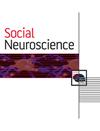Empathy, defending, and functional connectivity while witnessing social exclusion
IF 1.7
4区 医学
Q4 NEUROSCIENCES
引用次数: 0
Abstract
ABSTRACT Peers are present for most bullying episodes. Peers who witness bullying can play an important role in either stopping or perpetuating the behavior. Defending can greatly benefit victimized peers. Empathy is strongly associated with defending. Yet, less is known about defenders’ neural response to witnessing social distress, and how this response may relate to the link between empathy and defending. Forty-six first-year undergraduate students (M age = 17.7; 37 women), with varied history of peer defending, underwent fMRI scanning while witnessing a depiction of social exclusion. Functional connectivity analysis was performed across brain regions that are involved in cognitive empathy, empathetic distress, and compassion. History of defending was positively associated with functional connectivity (Exclusion > Inclusion) between the left orbitofrontal cortex (OFC) – medial prefrontal cortex (MPFC), and right OFC – left and right amygdalae. Defending was negatively associated with functional connectivity between the left OFC – anterior cingulate cortex. The relationship between history of defending and empathy (specifically, empathetic perspective taking) was moderated by functional connectivity of the right OFC – left amygdala. These findings suggest that coactivation of brain regions involved in compassionate emotion regulation and empathetic distress play a role in the relationship between empathy and peer defending.在目睹社会排斥的同时,移情、防御和功能连接
摘要大多数欺凌事件都有同伴在场。目睹欺凌行为的同龄人可以在阻止或延续这种行为方面发挥重要作用。辩护可以使受害的同龄人受益匪浅。同理心与防御密切相关。然而,对于维权者对目睹社会困境的神经反应,以及这种反应如何与同理心和维权之间的联系,人们知之甚少。46名一年级本科生(男性年龄=17.7;37名女性)有不同的同伴防御史,在目睹社会排斥的描述时,接受了功能磁共振成像扫描。对涉及认知移情、移情痛苦和同情的大脑区域进行了功能连接分析。防御史与左眶额皮质(OFC)-内侧前额叶皮质(MPFC)和右眶额皮质-左右杏仁核之间的功能连接(排除>包含)呈正相关。防御与左侧OFC-前扣带皮层之间的功能连接呈负相关。防御史和移情(特别是移情视角)之间的关系由右侧OFC和左侧杏仁核的功能连接调节。这些发现表明,参与同情情绪调节和移情痛苦的大脑区域的共同激活在移情和同伴防御之间的关系中发挥了作用。
本文章由计算机程序翻译,如有差异,请以英文原文为准。
求助全文
约1分钟内获得全文
求助全文
来源期刊

Social Neuroscience
医学-神经科学
CiteScore
3.40
自引率
5.00%
发文量
36
审稿时长
6-12 weeks
期刊介绍:
Social Neuroscience features original empirical Research Papers as well as targeted Reviews, Commentaries and Fast Track Brief Reports that examine how the brain mediates social behavior, social cognition, social interactions and relationships, group social dynamics, and related topics that deal with social/interpersonal psychology and neurobiology. Multi-paper symposia and special topic issues are organized and presented regularly as well.
The goal of Social Neuroscience is to provide a place to publish empirical articles that intend to further our understanding of the neural mechanisms contributing to the development and maintenance of social behaviors, or to understanding how these mechanisms are disrupted in clinical disorders.
 求助内容:
求助内容: 应助结果提醒方式:
应助结果提醒方式:


